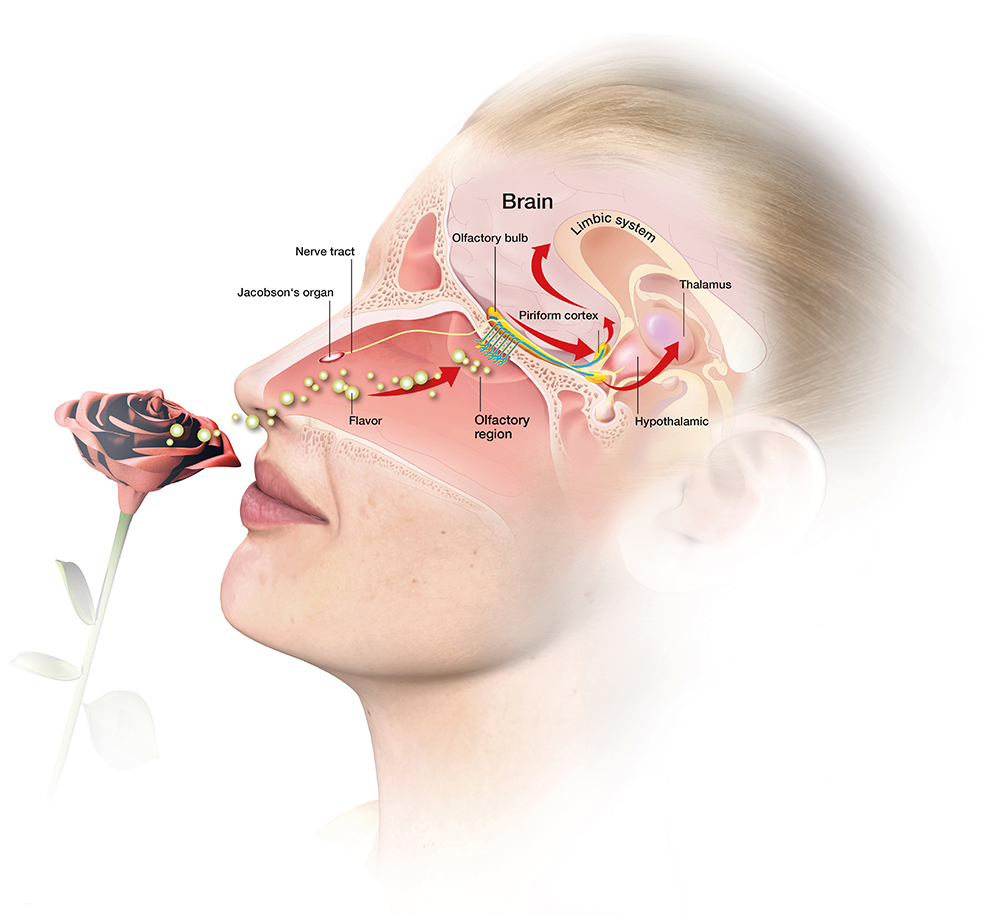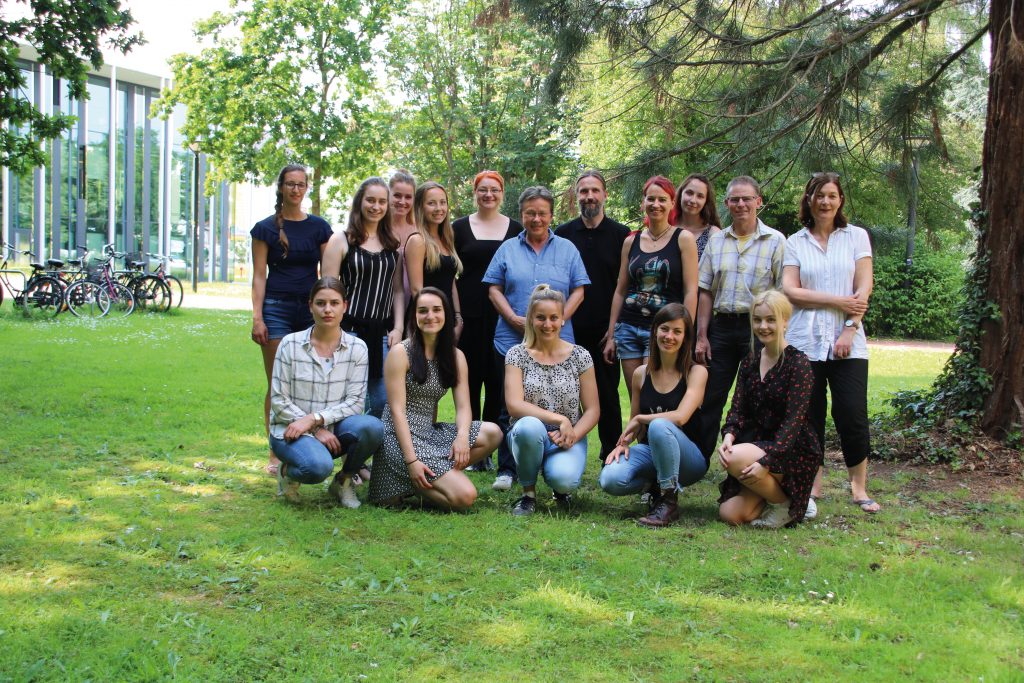Dr Bettina Pause – More than Just Words: The Chemical Communication of Social Information
As humans, we communicate our emotions to others in several different ways, including touch, motion, facial expression, and of course, speech. We can also communicate social information through chemosensory signals. Dr Bettina Pause, a professor at Heinrich-Heine-Universität Düsseldorf, has carried out extensive research exploring human communication and sensory perception, and in particular, how we quickly and effectively convey emotional states such as anxiety and aggression to others without even using words.
How Humans Communicate Emotion
Social communication is a vital human need, essential for survival and reproduction. Furthermore, the experience of isolation and loneliness can have serious repercussions on both our psychological and physical health. Strikingly, the negative impact of social exclusion on our wellbeing is comparable to that of high blood pressure, obesity, and smoking – three factors that are known to increase the risk of serious disease and even mortality.
In recent years, neuroscientists have found that one way in which we communicate social information to others is through chemosensory signals. These are chemical and sensory signals given off by humans, as well as other animals, in specific situations that can be detected by others through sensory perception, and in particular, the sense of smell. Although chemosensory communication is somewhat poorly understood at the current time, it does seem clear that it offers several evolutionary advantages.
So far, most research has investigated the neuronal underpinnings of social chemosensory signals primarily within the context of kin recognition, partner selection, reproductive state, and the phenomenon known as emotional contagion, which is our tendency to feel and express emotions that are similar to those around us.
Importantly, these signals do not appear to be processed within olfactory areas of the brain, but rather, in the regions responsible for processing social information, providing a very strong clue to their underlying function. The processing of social chemosensory signals appears to be very similar to the processing of other social signals although chemosensory signals are typically communicated in the absence of explicit awareness on the part of either the sender or the recipient.
Dr Bettina Pause, a professor of biological psychology at Heinrich-Heine-Universität Düsseldorf, has been investigating chemosensory communication among humans for several years. She leads one of the most prominent laboratories in the field and is responsible for significantly driving forward this exciting field of research. As Dr Pause notes, ‘The investigation of chemical communication offers a unique way to understand human social relationships.’
So far, Dr Pause and her colleagues have primarily investigated the chemosensory communication of stress, anxiety, and aggression. To measure chemosensory signals, they use axillary (armpit) sweat, urine, and blood samples. ‘Due to the high signal specificity, the long signal duration and the honest nature of the signal, chemical communication is phylogenetical ubiquitous and highly efficient,’ Dr Pause explains. ‘Multimodal studies show that in humans, chemical social signals are processed preferentially, but without cognitive interference.’

Olfaction in the Human Brain
Communicating Anxiety
From an evolutionary perspective, it is likely to be advantageous to communicate stress related to a potential threat to others around us – and chemosensory signals are a particularly effective way of doing this.
‘Chemosensory communication of stress between members of a given species is ubiquitous among the animal kingdom, as it promotes individual and group survival,’ says Dr Pause. Dr Pause has observed that stress can be transmitted from person to person on a subconscious level through chemosensory signals. ‘I have shown that humans are capable of effectively processing the chemosensory anxiety signals of other humans,’ Dr Pause explains. ‘These signals prime perceptual, neuronal, and motor systems in the perceiver, thereby stress-adaptive behaviour is triggered.’
Dr Pause’s findings suggest that the chemical communication of stress and anxiety between individuals could be contagious, with stress-related emotions being transmitted subconsciously from the stressed/anxious individual to others. Interestingly, however, both the person transmitting the stress and those perceiving it are unaware that this transmission is taking place. ‘The processing of chemosensory anxiety signals does not require attentional mediation,’ says Dr Pause. ‘On the contrary, the anxiety sweat samples we collected most often do not convey an olfactory impression.’ In other words, we are generally unaware of the information that we are either sending or perceiving through chemical communication.
Dr Pause has shown that the chemosensory signals associated with anxiety are primarily processed in empathy-related brain regions, rather than in those associated with olfaction. Moreover, she found that very anxious people tend to be more sensitive to stress-related chemosensory signals. ‘Chemosensory anxiety signals are preferentially processed in highly anxious individuals, demonstrating their high sensitivity to social cues of harm and danger,’ Dr Pause explains.
‘The investigation of chemical communication offers a unique way to understand human social relationships.’

Perceptions of Anxiety during Pregnancy
Dr Pause has also investigated the processing of anxiety-related chemosensory signals in pregnant women. She collected samples of axillary sweat from a group of men who were about to take an exam and presented them to non-pregnant women and women at different stages in their pregnancy. She then analysed the neuronal reactions in the brain to these samples of sweat to determine whether pregnant women differed in their sensitivity to the odour compared with non-pregnant women.
Interestingly, she found that pregnant women processed stress-related chemical signals significantly less than non-pregnant women, which suggests that pregnancy reduces the perception of anxiety. This reduced perception of anxiety could have an evolutionary explanation, as it ultimately prevents stress from affecting the baby’s development. ‘In pregnant females, the chemical contagion of anxiety seems to be absent,’ says Dr Pause. ‘As stress in the pregnant female can have fatal consequences for the health of new-borns, the reduction of stress perception in pregnant women protects the physiological and psychological health of offspring.’
Communicating Aggression
Dr Pause has also explored the human chemosensory communication of aggression. To do this, she collected sweat from a group of men and women who were taking part in either a very competitive computer game that was meant to raise their aggression levels or a non-competitive construction game. These sweat samples were then presented to other men and women and their neurobiological responses were analysed. Dr Pause and her colleagues found that the chemosensory signals of aggression given off by males elicited peak activity in the brains of both men and women, with women responding more strongly.
In other words, detecting male aggression signals appears to be of greater importance for women than for men. Typically, males are physically stronger than females and thus aggression could pose a greater threat, so it is advantageous for females to be more responsive. ‘Our recent studies show that not only stress and anxiety, but also aggression can be transmitted between humans via chemosensory signals’ confirms Dr Pause.

Olfactory Perception and Depression
Past studies have suggested that the emotional system of mammals has partly evolved from their olfactory system. For instance, studies on rats have shown that regions associated with olfaction form a close relationship with the cortical amygdala, which is associated with emotion, survival instinct, and memory.
Dr Pause explored whether maladaptive emotional states, such as depression, are associated with different olfactory processing. She found that depressed patients have a reduced sensitivity to odours; a finding that was later replicated by other laboratories worldwide. While this reduced sensitivity to odours was primarily observed in individuals suffering from major depressive disorder, it was also sometimes present in healthy individuals experiencing temporary depressive states.
Dr Pause’s explanation for the decreased sensitivity to odours she observed in people suffering from depression is that their olfactory bulb, the primary brain region involved in processing smells, may be dysfunctional. ‘A dysfunctional olfactory bulb could result in an over-activation of brain areas related to negative emotional states, such as the amygdala,’ says Dr Pause. ‘Later studies confirmed that I was right, as they found the olfactory bulb in depressive patients to be reduced in size.’
‘Our recent studies show that not only stress and anxiety, but also aggression can be transmitted between humans via chemosensory signals.’

Paving the Way for Fascinating New Discoveries
In very recent work, Dr Pause has been investigating the mechanisms of episodic memory, that is, the ability of humans to remember and mentally ‘re-experience’ particular episodes from their past, as well as its relationship to emotional and odour processing. In addition, she has been exploring social communication in homosexual individuals. So far, her findings suggest that homosexual individuals dampen interpersonal conflicts by showing reduced aggressive and increased empathic social skills. However, most of her present work is still dedicated to the definition of conditions which compose a chemical signal from a mixture of socially derived volatile molecules
The research already carried out by Dr Pause and her colleagues offers valuable insight into how the human brain responds to chemosensory signals, particularly those associated with stress, anxiety, and aggression. Dr Pause’s observations undoubtedly pave the way for further discoveries about chemosensory communication of emotions among humans, as well as the relationship between olfactory processing and mental health.
Reference
https://doi.org/10.33548/SCIENTIA446
Meet the researcher

Dr Bettina M Pause
Department of Experimental Psychology
Heinrich-Heine-Universität Düsseldorf
Universitätsstr.1, 40225 Düsseldorf
Germany
Dr Bettina Pause has been a professor of biological psychology at Heinrich-Heine-Universität for over ten years. She obtained her PhD in psychology from the University of Kiel, where she also worked as a scientific assistant for several years. In addition to her academic studies at the University of Kiel, Dr Pause has completed several short specialisation courses and participated in a variety of research projects at different universities worldwide. In 1997, for instance, she conducted research at the Washington and Lee University in Virginia (USA), funded by a scholarship from the Gustav-Lienert Foundation. Over the course of her career, Dr Pause has published a vast number of papers in renowned scientific journals investigating topics including the functionality of olfactory information processing in humans and implicit social communication via chemical signals. In 2009, Dr Pause received the Reinhard-Heynen and Emmi-Heynen-Preis prize for outstanding scientific achievements from Heinrich-Heine-Universität. In March 2020, Dr Pause’s book introducing human chemical communication to a broad audience, titled ‘Alles Geruchssache’ and published by Piper Verlag, will become available on the German market.
CONTACT
E: Bettina.Pause@uni-duesseldorf.de
W: http://www.psychologie.hhu.de/en/research-teams/bsp.html
FUNDING
German Research Foundation (DFG)
REFERENCES
BM Pause, D Storch, KT Lübke, Chemosensory communication of aggression: Women’s fine-tuned neural processing of male aggression signals, Philosophical Transactions of the Royal Society B, In Press.
BM Pause, Human Chemosensory Communication, Springer Handbook of Odor, 2017, 52, 987–1010.
KT Lübke, A Busch, M Hoenen, B Schaal, BM Pause, Pregnancy reduces the perception of anxiety, Scientific Reports, 2017, 1–11.
KT Lübke, BM Pause, Always follow your nose: The functional significance of social chemosignals in human reproduction and survival, Hormones and Behavior, 2015, 68, 134–144.
S Schablitzky, BM Pause, Sadness might isolate you in a non-smelling world: Olfactory perception and depression, Frontiers in Psychology, 2014, 5, 45, 1–20.
BM Pause, Processing of Body Odor Signals by the Human Brain, Chemosensory Perception, 2012, 5, 55–63.
A Prehn-Kristensen, C Wiesner, TO Bergmann, S Wolff, O Jansen, HM Mehdorn, R Ferstl, BM Pause, Induction of empathy by the smell of anxiety, PloS One, 2009, 4, 6, e5987.
BM Pause, A Miranda, R Göder, JB Aldenhoff, R Ferstl, Reduced olfactory performance in patients with major depression, Journal of Psychiatric Research, 2001, 35, 5, 271–277.

Creative Commons Licence
(CC BY 4.0)
This work is licensed under a Creative Commons Attribution 4.0 International License. 
What does this mean?
Share: You can copy and redistribute the material in any medium or format
Adapt: You can change, and build upon the material for any purpose, even commercially.
Credit: You must give appropriate credit, provide a link to the license, and indicate if changes were made.
More articles you may like
Grandmothers: Innovation Through Tradition
Grandmother Project – Change through Culture (GMP) is an organisation dedicated to documenting the role of grandmothers and demonstrating the effectiveness of grandmother-inclusive strategies in improving the health and well-being of women, children, and adolescents. GMP’s groundbreaking work challenges conventional wisdom to transform community-based interventions in Africa and beyond, harnessing a powerful but often overlooked resource: the wisdom and influence of grandmothers.
Dr Robert Larkin | Cultivating Change to Improve Soil Health and Increase Potato Yield
Environmental quality and food production are facing the pressing challenges of climate change and global population growth. Dr Robert Larkin from the United States Department of Agriculture-Agricultural Research Service (USDA-ARS) and a team of plant scientists developed and tested a range of crop management systems to help overcome these compounding challenges. Their work is improving soil health and increasing the yield of potato crops, contributing to the future food security of nations.
Professor Giorgio Buttazzo | Artificial Intelligence and a Crossroads for Humanity
Where do we stand with artificial intelligence? Might machines take over our jobs? Can machines become conscious? Might we be harmed by robots? What is the future of humanity? Professor Giorgio Buttazzo of Scuola Superiore Sant’Anna is an expert in artificial intelligence and neural networks. In a recent publication, he provides considered insights into some of the most pressing questions surrounding artificial intelligence and humanity.
Dr Ralf Adam | New Technologies Shaping the Future of Oral Hygiene
Understanding the efficiency of various toothbrush technologies is essential for achieving optimal oral health. Dr Ralf Adam, who leads a dedicated team at Procter & Gamble in Germany, is keen to investigate the complexities of these technologies. His team have provided new insights into the best toothbrush types for plaque removal and the maintenance of gum health. By highlighting the importance of informed oral care decisions and ongoing investigations, this vital research works towards ensuring everyone can achieve a brighter, healthier smile.




